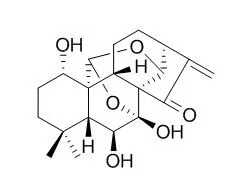| Kinase Assay: |
| Int J Mol Sci. 2015 Jan 12;16(1):1576-89. | | Ponicidin induces apoptosis via JAK2 and STAT3 signaling pathways in gastric carcinoma.[Pubmed: 25588213] | Ponicidin has a variety of biological effects such as immunoregulatory and anti-inflammatory functions as well as anti-viral functions especially in the upper respiratory tract infection. This study was aimed to elucidate the antitumor effect of Ponicidin in gastric carcinoma MKN28 cells and the possible molecular mechanism involved.
METHODS AND RESULTS:
Cell viability was measured by the Cell Count Kit-8 (CCK8). Cell apoptosis was assessed by flow cytometry as well as cell cycle and reactive oxygen species (ROS) analysis. Western blot analysis was used to detect the active form of caspase-3 as well as Bax and B-cell lymphoma-2 (Bcl-2) expressions after cells were treated with different concentrations of Ponicidin. The results revealed that Ponicidin could inhibit the growth of MKN28 cells significantly in both a time- and dose-dependent manner. The cell cycle was blocked and ROS generation was increased after the cells were treated with Ponicidin. Bcl-2 expression was down-regulated remarkably while Bax expression and the active form of caspase-3 were increased after apoptosis occurred.
CONCLUSIONS:
We therefore conclude that Ponicidin exhibited significant growth inhibition of gastric carcinoma cell line MKN28 and induced apoptosis of MKN28 cells via the signaling pathway regulated by Janus kinase 2 (JAK2) and signal transducers and activators of transcription 3 (STAT3). Ponicidin may serve as a potential therapeutic agent for gastric carcinoma. | | Cancer Invest. 2006 Mar;24(2):136-48. | | Ponicidin, an ent-kaurane diterpenoid derived from a constituent of the herbal supplement PC-SPES, Rabdosia rubescens, induces apoptosis by activation of caspase-3 and mitochondrial events in lung cancer cells in vitro.[Pubmed: 16537182] | Ponicidin, an ent-kaurane diterpenoid derived from a constituent of the herbal supplement PC-SPES, Rabdosia rubescens, is recently reported to have anti-tumor effects on a large variety of cancers.
METHODS AND RESULTS:
In this study, we demonstrate that Ponicidin exhibits cytotoxicity, induces apoptosis, disrupts the mitochondrial membrane potential, and triggers the activation of caspase-3, -8 and -9 in lung cancer A549 and GLC-82 cells. Ponicidin treatment of lung cancer cells caused downregulation of anti-apoptotic protein Bcl-2 and survivin as well as upregulaton of pro-apoptotic protein Bax in a time dependent manner when apoptosis ocurred. Ponicidin induced activation of caspase-3 can be blocked by a caspase-3-specific inhibitor z-DEVD-FMK Furthermore, the caspase-8-specific inhibitor z-IETD-FMK could block the Ponicidin-induced activation of caspase-3, PARP cleavage, and prevented the release of cytochrome c from mitochondria into the cytoplasm. This indicate that activated caspase-8 initiates the release of cytochrome c during Ponicidin-induced apoptosis. We therefore conclude that Ponicidin has significant apoptosis-inducing effects by activation of caspase-3 -8, and -9 as well as downregulation of anti-apoptotic protein Bcl-2, survivin and upregulation of pro-apoptotic protein Bax, with caspase-8 acting as an upstream activator.
CONCLUSIONS:
The data offer a potential mechanism for Ponicidin-induced apoptosis in lung cancer cells, suggesting that Ponicidin may severve as an effective reagent for the treatment of lung cancer, and that in vivo anti-cancer effects as well as its potential clinical effectiveness need further investigation. |
|
| Cell Research: |
| Cancer Gene Ther. 2000 Jan;7(1):45-52. | | Potentiation of ganciclovir toxicity in the herpes simplex virus thymidine kinase/ganciclovir administration system by ponicidin.[Pubmed: 10678355] | We have evaluated the effect of Ponicidin, a diterpenoid isolated from a plant, Rabdosia ternifolia, on the cell-killing activity of the anti-herpes drugs acyclovir (ACV) and GCV. Ponicidin preferentially activated HSV-1-specific TK but not cellular kinases.
METHODS AND RESULTS:
In HSV-infected cells, Ponicidin significantly accumulated the phosphorylated metabolites of GCV and suppressed the extracellular release of GCV. These data suggested that the cytotoxicities of ACV and GCV in HSV-TK-expressing cells might be potentiated by Ponicidin. After transfected with the HSV-1 TK gene, COS-1 and several human cancer cells became highly sensitive to the cytotoxic properties of the nucleoside analogs. When Ponicidin at the concentration without antiviral activities (0.2 microg/mL) was combined with ACV or GCV, the cytotoxic levels in HSV-TK-expressing cells were enhanced by 3- to 87-fold and 5- to 52-fold, respectively, compared with the nucleoside alone. When the stability of the bioactivity of Ponicidin in the blood of mice was evaluated, the substance showed relatively long-lasting effects on the potentiation of the anti-herpetic and cytotoxic activities of GCV after intravenous administration.
CONCLUSIONS:
These data suggest that the combined use of Ponicidin with GCV will be effective for cancer gene therapy, because high cytotoxicity in viral TK-expressing cells should yield more rapid and enhanced tumor elimination. |
|






 Cell. 2018 Jan 11;172(1-2):249-261.e12. doi: 10.1016/j.cell.2017.12.019.IF=36.216(2019)
Cell. 2018 Jan 11;172(1-2):249-261.e12. doi: 10.1016/j.cell.2017.12.019.IF=36.216(2019) Cell Metab. 2020 Mar 3;31(3):534-548.e5. doi: 10.1016/j.cmet.2020.01.002.IF=22.415(2019)
Cell Metab. 2020 Mar 3;31(3):534-548.e5. doi: 10.1016/j.cmet.2020.01.002.IF=22.415(2019) Mol Cell. 2017 Nov 16;68(4):673-685.e6. doi: 10.1016/j.molcel.2017.10.022.IF=14.548(2019)
Mol Cell. 2017 Nov 16;68(4):673-685.e6. doi: 10.1016/j.molcel.2017.10.022.IF=14.548(2019)